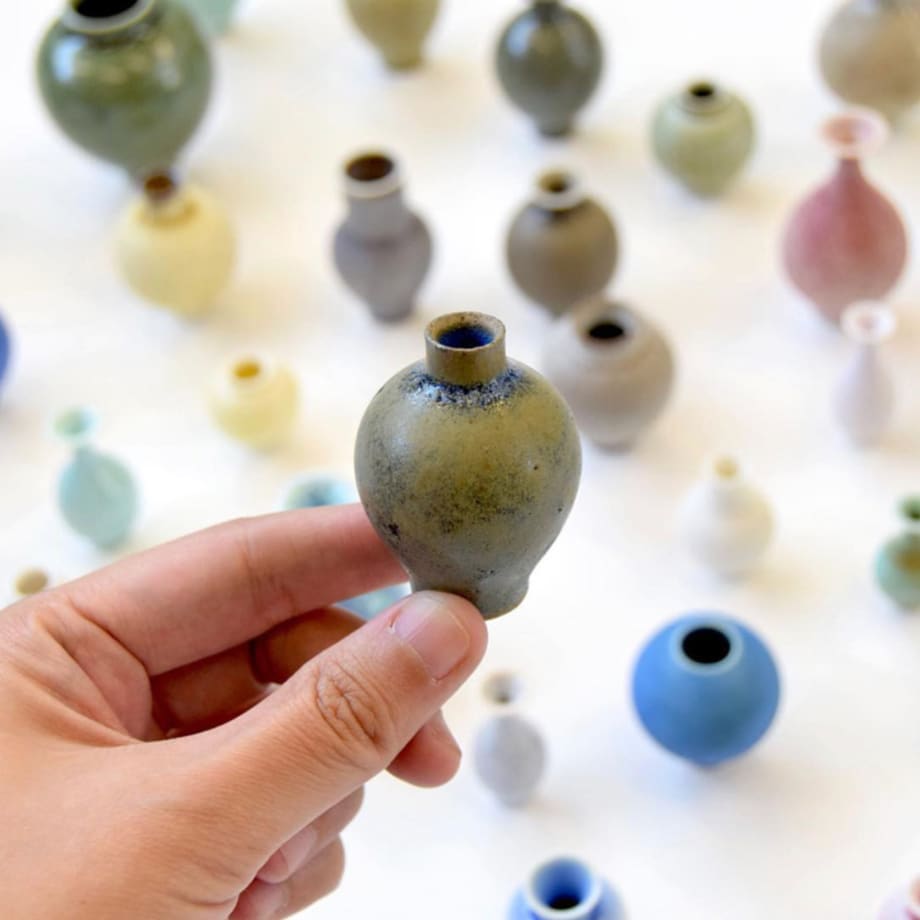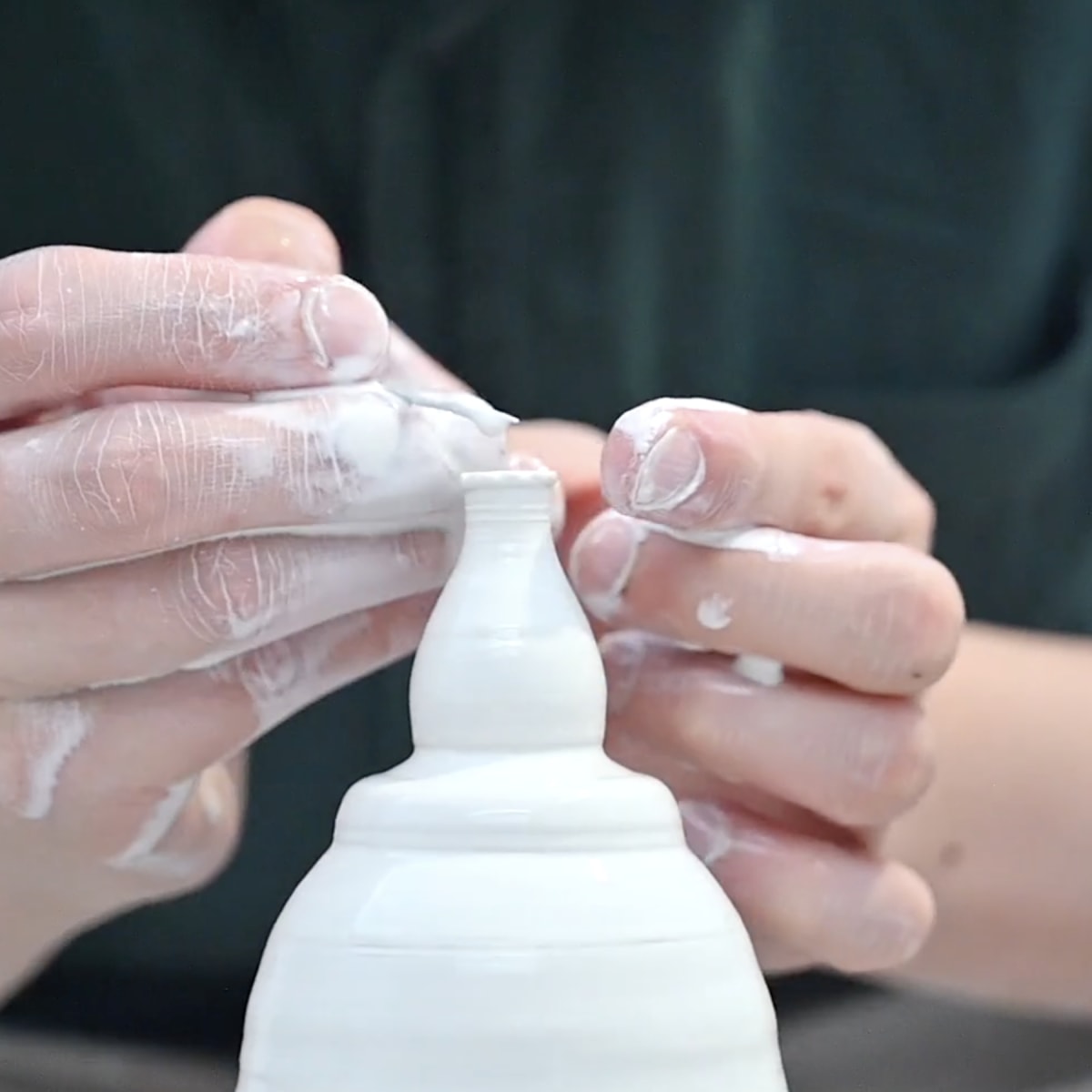Yuta Segawa Japanese, b. 1988
-
OverviewMiniature pottery defines the relationship between a maker's physicality and the finished work. Testing the limits of what a human can produce on such a small scale is a challenge.Japanese ceramicist Yuta Segawa plays with scale and colour in producing his miniature glazed stoneware, terracotta and porcelain pots. Soil, though difficult to control on the wheel, is another source material that produces singular textures. His skills have been developed in the Far East and the UK, where he now lives and has a studio. He combines an Eastern ceramic tradition with the influence of Scandinavian artists who specialise in miniature. Wilhelm Kage, Stig Lindberg, Berndt Friberg, Gunnar Nylund, and Carl Harry Stalhanem have all made a big impression. Each unique vessel is hand-thrown with extraordinary attention to detail, structure and surface. He constantly experiments with finishes and has developed over five hundred different glazes.
To accentuate the colours and ceramics' tiny size, Segawa often displays them in long, neat rows or arranged in a scattered formation that allows for a subtle shift between warm and cool colours.
He has exhibited in Japan, China, the UK, the Netherlands, Dubai, and India. His affordability has allowed many hundreds of private individuals to collect his work. His ceramics are also held in the collection of the University of The Arts, London.
£25 - £110Please email the gallery for information about ceramics currently for sale
-
Works
-
 Miniature Teapot (BU39), 2024
Miniature Teapot (BU39), 2024 -
 Miniature Pot (BO117), 2023
Miniature Pot (BO117), 2023 -
 Miniature Bowl (PDCAB1), 2024
Miniature Bowl (PDCAB1), 2024 -
 Minature Bowl (PDCAB4), 2024
Minature Bowl (PDCAB4), 2024 -
 Miniature Bowl (PDCAB3), 2024
Miniature Bowl (PDCAB3), 2024 -
 Miniature Bowl (PDCAB5), 2024
Miniature Bowl (PDCAB5), 2024 -
 Teapot (BU61), 2023
Teapot (BU61), 2023 -
 Teapot (BU105), 2023
Teapot (BU105), 2023 -
 Teapot (BU64), 2023
Teapot (BU64), 2023 -
 Miniature Pot (PDCA17), 2022
Miniature Pot (PDCA17), 2022 -
 Miniature Pot and Cover (AH125), 2022
Miniature Pot and Cover (AH125), 2022 -
 Miniature Pot and Cover (AH4), 2022
Miniature Pot and Cover (AH4), 2022 -
 Miniature Pot (PDCA11), 2022
Miniature Pot (PDCA11), 2022 -
 Miniature Pot (PDCA26), 2022
Miniature Pot (PDCA26), 2022 -
 Miniature Pot and Cover (AH22), 2022
Miniature Pot and Cover (AH22), 2022 -
 Miniature Pot and Cover (AH40), 2022
Miniature Pot and Cover (AH40), 2022 -
 Miniature Pot (PDCA34), 2022
Miniature Pot (PDCA34), 2022 -
 Miniature Pot and Cover (AH81), 2022
Miniature Pot and Cover (AH81), 2022 -
 Miniature Pot and Cover (AH85), 2022
Miniature Pot and Cover (AH85), 2022 -
 Miniature Pot and Cover (AH99), 2022
Miniature Pot and Cover (AH99), 2022 -
 Miniature Pot and Cover (AH102), 2002
Miniature Pot and Cover (AH102), 2002 -
 Miniature Pot (PDCA12), 2022
Miniature Pot (PDCA12), 2022 -
 Miniature Pot (PDCA13), 2023
Miniature Pot (PDCA13), 2023 -
 Miniature Pot (PDCA14), 2022
Miniature Pot (PDCA14), 2022 -
 Miniature Pot (PDCA15), 2022
Miniature Pot (PDCA15), 2022 -
 Miniature Pot (PDCA19), 2022
Miniature Pot (PDCA19), 2022 -
 Miniature Pot (CER5), 2022
Miniature Pot (CER5), 2022 -
 Miniature Pot (CER6), 2022
Miniature Pot (CER6), 2022 -
 Miniature Pot (CER2), 2022
Miniature Pot (CER2), 2022 -
 Miniature Pot (CER1), 2022
Miniature Pot (CER1), 2022 -
 Miniature Pot (PDCA30), 2022
Miniature Pot (PDCA30), 2022 -
 Yuta Segawa (PB142), 2023
Yuta Segawa (PB142), 2023 -
 Miniature Pot (BH30), 2023
Miniature Pot (BH30), 2023 -
 Minitaure Pot (BP14), 2023
Minitaure Pot (BP14), 2023 -
 Miniature Pot (BO15), 2023
Miniature Pot (BO15), 2023 -
 Miniature Pot (BC02), 2023
Miniature Pot (BC02), 2023
-
-

-
Yuta In Conversation
Patrick Davies talks to with the artistI have long admired the beauty and resonance of Yuta’s miniature creations. There is an intimate charm to these objects that are so tiny and devoid of function. They are highly affordable, costing less than £100 for each unique piece.
YOU WERE BORN IN SHIZUOKA, JAPAN. DO YOU COME FROM A CREATIVE BACKGROUND?
I grew up in Shizuoka, part of a family of seven. I lived with my father, mother, grandfather, grandmother, and two older brothers. My parents had no connection or particular interest in art, and I was not very interested in ceramics.
WHEN DID YOU REALISE YOU WANTED TO BECOME AN ARTIST, AND WHY DID YOU CHOOSE CERAMICS?
I became interested in ceramics when I took part in a short ceramic program as a first-year university student studying product design. I loved it and saw massive potential. As a result, I changed my course to ceramics. I wasn’t interested in ceramics before this point, but I liked reading historical novels about Japanese and Chinese history while growing up. Ceramics have been produced in Japan and China in various periods and have been influenced by each period’s culture, geographical condition, economy, and ethnicity. My interest in history drew me into making ceramics.
HOW WOULD YOU DESCRIBE YOURSELF - ‘A CERAMIC ARTIST’ - A ‘MAKER’ - ‘A DESIGNER’?
I would say that I am an artist exploring ceramic materialities, such as the texture of clay, the beauty of glaze, and throwing techniques. I am trying to make something new that no one has created by these explorations. I believe I am making art.
YOUR WORK CONCENTRATES ON THE SMALL SCALE. WHEN DID YOU FIRST BEGIN MAKING TINY CERAMICS, AND WHAT ARE THE CHALLENGES?
I am making tiny pots which can be placed on one hand. Testing the limits of what a human body can make on such a small scale is a challenge. There is a charm and beauty to objects that are minute and have no function. I made my first miniatures in 2012, influenced by Scandinavian ceramic artists and Chinese emperor’s toy boxes made in the Qing dynasty. Small pots seemed very interesting and suitable for my ideas because they did not need a large scale to express the beauty of clay, glazes, and shapes.
WHAT TYPE OF CLAY DO YOU USE?
I use many kinds, such as porcelain, terracotta, and stoneware, and I also use soil that I mine from the ground. Soil is challenging to control on a wheel but has an attractive texture. My works are usually fired at more than 1250 degrees centigrade in the kiln.
AFTER GRADUATING FROM MUSASHINO ART UNIVERSITY IN TOKYO, HOW DID YOU CONTINUE TO DEVELOP YOUR INTEREST IN ART AND CERAMICS?
Following my BA course in Japan, I worked in China at a pottery workshop in Jingdezhen, a city famous for producing ceramics. I treated ceramics as one of the materials for making sculptures, and I was influenced by contemporary fine art and sculpture-making at that time. I tried other materials and began cultivating a desire to work as a fine artist. Young artists of my generation were also making sculptures influenced by the rapid import of Western culture into China. I thought, ‘Why are they making such insignificant works even though they have inherited great Chinese traditions and techniques of ceramics making, such as celadon and blue and white porcelain?’ That criticism applies to me, too, because I was making similar sculptures when I learnt about great Japanese and Chinese ceramics. After returning to Japan, I began thinking about what aspect of ceramics most attracted me. When I started studying ceramics, I initially felt a strong affiliation with the work of my first tutor, Makoto Komatsu, as well as the artists Wilhelm Kage, Stig Lindberg, and Berndt Friberg, who were based in Gustavsberg, Sweden. However, I also liked postwar Japanese great masters such as Rosanjin Kitaoji, Munemaro Ishiguro, and Syoji Hamada. When I thought about what I wanted to make, I was drawn to developing miniature pottery like Lindberg and Friberg. I believed I could make something new if I made use of Japanese traditions and techniques. So, I came to London and started to concentrate on creating something new using the concept of miniature pots.
WHY DID YOU CHOOSE TO COME TO LONDON TO STUDY AT CAMBERWELL FOR YOUR MA?
Most contemporary Japanese artists have an inferiority complex regarding European and American art. I was also one of them. We believe that the main markets are in Western countries and that mainstream art revolves around Western history. I did not know how to create original work, so I imitated Western art. That’s also why I believed I had to experience the culture of New York or London to develop something unique. Therefore, I chose London, which has a long ceramic history. In addition, it seemed like British ceramic artists were influenced by Grayson Perry, who explored the new presentation of ceramics, and many of them were trying to make something new.
WHICH OTHER ARTISTS DO YOU ADMIRE AND WHY? DO ANY DIRECTLY INFLUENCE YOUR WORK?
The Scandinavian artists Wilhelm Kage, Stig Lindberg, Berndt Friberg, Gunnar Nylund, and Carl Harry Stalhanem have made a big impression. They created miniature pottery, and they were my starting point. So I see my work as a continuation of their tradition.
HOW DO YOU SEE YOUR WORK DEVELOPING IN THE NEXT FEW YEARS?I have exhibited in Japan, China, the UK, the Netherlands, Dubai, and India. Every country has a diverse ceramic culture that has developed individually. I want to obtain inspiration from as many as possible and to reflect that diversity in my work. The point of making is to leave evidence of my life in the world. I aim to make hundreds of thousands of works, as many as possible. -
Videos
-








































